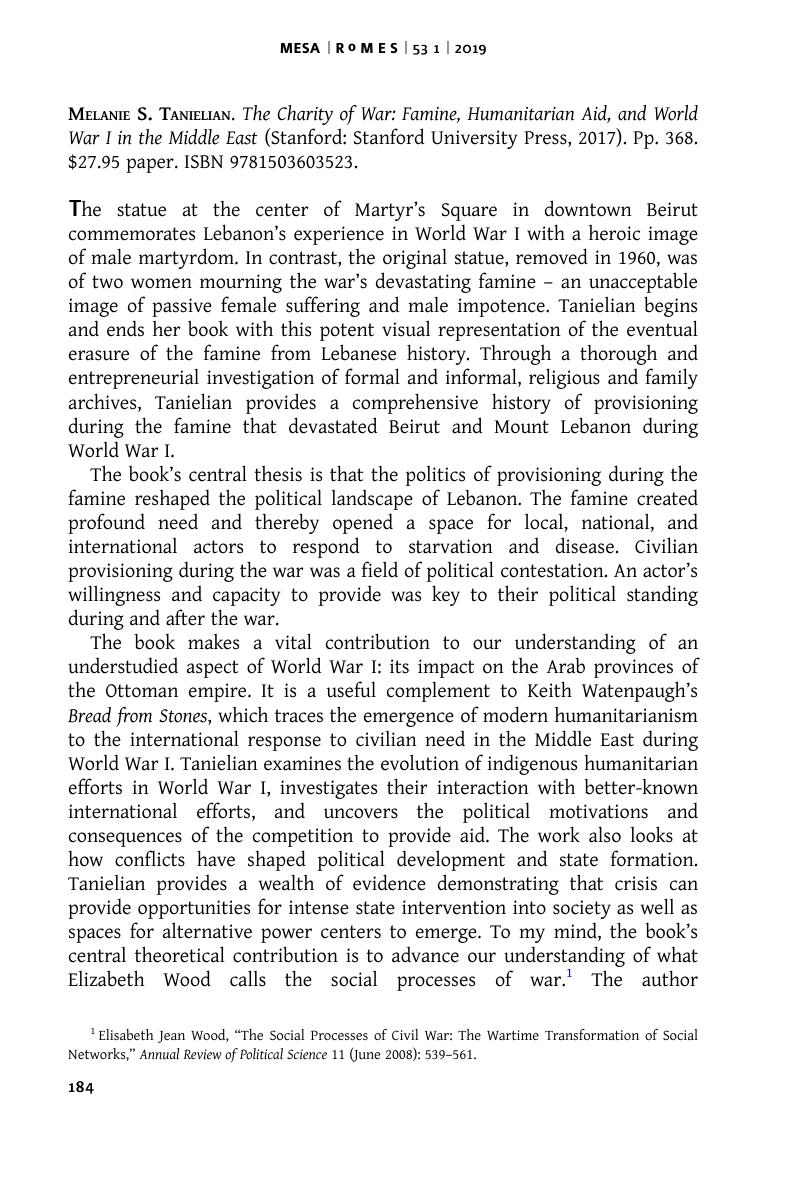The statue at the center of Martyr's Square in downtown Beirut commemorates Lebanon's experience in World War I with a heroic image of male martyrdom. In contrast, the original statue, removed in 1960, was of two women mourning the war's devastating famine – an unacceptable image of passive female suffering and male impotence. Tanielian begins and ends her book with this potent visual representation of the eventual erasure of the famine from Lebanese history. Through a thorough and entrepreneurial investigation of formal and informal, religious and family archives, Tanielian provides a comprehensive history of provisioning during the famine that devastated Beirut and Mount Lebanon during World War I.
The book's central thesis is that the politics of provisioning during the famine reshaped the political landscape of Lebanon. The famine created profound need and thereby opened a space for local, national, and international actors to respond to starvation and disease. Civilian provisioning during the war was a field of political contestation. An actor's willingness and capacity to provide was key to their political standing during and after the war.
The book makes a vital contribution to our understanding of an understudied aspect of World War I: its impact on the Arab provinces of the Ottoman empire. It is a useful complement to Keith Watenpaugh's Bread from Stones, which traces the emergence of modern humanitarianism to the international response to civilian need in the Middle East during World War I. Tanielian examines the evolution of indigenous humanitarian efforts in World War I, investigates their interaction with better-known international efforts, and uncovers the political motivations and consequences of the competition to provide aid. The work also looks at how conflicts have shaped political development and state formation. Tanielian provides a wealth of evidence demonstrating that crisis can provide opportunities for intense state intervention into society as well as spaces for alternative power centers to emerge. To my mind, the book's central theoretical contribution is to advance our understanding of what Elizabeth Wood calls the social processes of war.Footnote 1 The author demonstrates that an actor's perceived success or failure in provisioning has the power to reshape legitimacy, patterns of allegiance, and political networks in the post-war period.
Chapter 1 identifies prewar economic changes that made the region exceptionally vulnerable to famine, while Chapter 2 examines the political causes. The next two chapters chronicle the competition to feed civilians and its consequences. Chapter 3 documents the struggle for political power and legitimacy between the Ottoman state and local notables on the Beirut municipal council; ultimately, both actors failed to prevent starvation and were politically discredited. Chapter 4 analyses the Maronite church's efforts to reclaim political prominence in Mt. Lebanon through accommodation with the Ottomans and through using preexisting institutions, thereby undermining secular elites.
Chapter 5 chronicles the struggle against infectious diseases, revealing an image of a militant state whose intervention into society becomes increasingly invasive. In contrast to the competition over food provision, fighting disease was a less crowded space because the political payoffs were minimal. Putting strictures on citizen behavior did not engender support for the state. This is an important insight – that different humanitarian sectors can have contrasting political dynamics depending on popular perceptions of the efforts undertaken.
Chapter 6 documents the relief work done by local civil society and charitable associations. The Ottoman state worked to systematically undermine local notables’ efforts. The exception were women. The freedoms given to women's groups are a testament to the state's gendered view of who constituted a political threat. Chapter 7 examines international humanitarian efforts and demonstrates how political calculus – including a self-conscious but often illusory distancing from great power politics – figured in the provisioning done by missionaries.
The concluding chapter addresses the post-war period. How to remember the famine and its aftermath becomes a critical point of contention in the political discourse. Francophile nationalists saw it as an episode of Christian suffering, betrayal by Arab grain-producing cities, and French liberation. Those supporting union with Syria portrayed the famine as a cross-communal suffering, questioned France's effectiveness, and brought attention to post-war provision by local actors. Remembering the famine became a key vehicle for the emergence of contradictory visions of Lebanon's future.
The main weakness of the book is a lack of clarity regarding the causal weight of wartime provisioning in shaping the postwar landscape. The military outcome of the war and French colonial policy were also significant in shaping post-war politics. At times, it seems unclear how wartime provisioning interacts and competes with these alternative explanations. For instance, the author acknowledges that some local notables who had failed to provide aid eventually managed to resuscitate their public image after the war. The church was empowered not just by wartime provisioning, but also by French authorities. The Ottoman state was undermined not just by its failures to provide, but also by its loss of the war. Women's associations and U.S. missionaries were successful providers but did not see their political influence increase dramatically. While the author presents convincing evidence that provisioning contributed to shaping actors’ post-war fortunes, these examples cast some doubt on the relative importance of provisioning.
This weakness, however, does not take away from the book's multiple strengths. Tanielian's remarkable work, which weaves together a variety of difficult-to-acquire source material, significantly advances our understanding of life in the Arab provinces of the Ottoman Empire during World War I. In addition, the book makes important theoretical contributions with broad implications. This study clearly demonstrates how the political and humanitarian are intertwined, especially in a total war which fully politicizes the civilian body. It also illuminates pathways through which war remakes society and the state, altering gender roles, shifting loyalties, legitimizing some actors, discrediting others, and creating spaces for new centers of power to emerge. These insights are undoubtedly relevant for those studying contemporary conflicts in the region.



